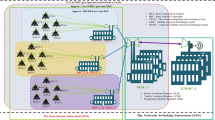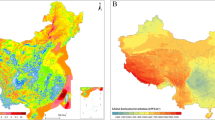Abstract
China is rich in solar and wind energy resources, of which the proportion of China’s power sources has been rapidly increasing. Such fluctuating and intermittent energy sources will bring significant challenges to the safe and stable operation power system. However, making use of the spatiotemporal complementarities between different renewable energy resources is a feasible way to level fluctuating power especially when they have a widely geographical dispersion. Based on the data provided by China Meteorological Administration (CMA), this research explores the spatiotemporal complementarities between wind and solar energy resources. This paper nondimensionalizes hourly wind speed and global solar radiation data and employs several indexes to compare the smoothing effect with various combining scenarios. The results show that combining wind and solar powers within a certain area can cause a fall of zero-power or very-full power hours. Besides, combining different resources improves ‘smoothness’ in power output when compared with that from each individual resource. However, under hourly time scale, when the dispersion of sites is large enough, the smoothing effect of combining the dispersed wind power is very close to the combination of those two different resources. Nevertheless, this complementary effect is much better than that of just combining solar energy resources.
Similar content being viewed by others
References
Sarkar S, Ajjarapu V. MW resource assessment model for a hybrid energy conversion system with wind and solar resources. Sustain Energy, IEEE T, 2011, 2(4): 383–391
Li J, Cai F, Tang W, et al. China Wind Power Outlook 2011. Beijing: China Environmental Science Press, 2010
Guo L, Zhao L, Jing D, et al. Solar hydrogen production and its development in China. Energy, 2009, 34(9): 1073–1090
Wang S, Hao J. Air quality management in China: Issues, challenges, and options. J Environ Sci, 2012, 24(1): 2–13
Liu J, Liu Y, Zeng D, et al. Optimal short-term load dispatch strategy in wind farm. Sci China Tech Sci, 2012, 55(4): 1140–1145
Gao Y, Pan J, Yang Z, et al. Optimization based accurate scheduling for generation and reserve of power system. Sci China Tech Sc, 2012, 55(1): 223–232
Dahal S, Mithulananthan N, Saha T K. Assessment and enhancement of small signal stability of a renewable-energy-based electricity distribution system. Sustainable Energy, IEEE T, 2012, 3(3): 407–415
Kahn E. The reliability of distributed wind generators. Electric Power Systems Research, 1979, 2(1): 1–14
Simonsen T K, Stevens B G. Regional wind energy analysis for the central United States. Proc Global Wind Power 2004, American Wind Energy Association, Chicago, 2004
DeCarolis J F, Keith D W. The economics of large-scale wind power in a carbon constrained world. Energy Policy, 2006, 34(4): 395–410
Oswald J, Raine M, Ashraf-Ball H. Will British weather provide reliable electricity? Energy Policy, 2008, 36(8): 3212–3225
Kempton W, Pimenta FM, Veron D E, et al. Electric power from offshore wind via synoptic-scale interconnection. PNAS USA, 2010, 107(16): 7240–7245
Katzenstein W, Fertig E, Apt J. The variability of interconnected wind plants. Energy Policy, 2010, 38(8): 4400–4410
Liu Y, Xiao L Y, Wang H F, et al. Investigation on the spatiotem-poral complementarity of wind energy resources in China. Sci China Tech Sci, 2012, 55(3): 725–734
Burton T, Sharpe D, Jenkins N, et al. Wind Energy Handbook. New York: Wiley, 2002. 173–207
Mills A, Ahlstrom M, Brower M, et al. Understanding variability and uncertainty of photovoltaics for integration with the electric power system. IEEE Power Energ Mag, 2011, 9(3): 33–41
Murata A, Yamaguchi H, Otani K. A method of estimating the output fluctuation of many photovoltaic power generation systems dispersed in a wide area. Elec Eng Jpn, 2009, 166(4): 9–19
Jacobson M Z, Delucchi M A. Providing all global energy with wind, water, and solar power, part I: Technologies, energy resources, quantities and areas of infrastructure, and materials. Energy Policy, 2011, 39(3): 1154–1169
Markvart T. Sizing of hybrid photovoltaic-wind energy systems. Solar Energy, 1996, 57(4): 277–281
Ai B, Yang H, Shen H, et al. Computer-aided design of PV/wind hybrid system. Renew Energy, 2003, 28(10): 1491–1512
Diaf S, Diaf D, Belhamel M, et al. A methodology for optimal sizing of autonomous hybrid PV/wind system. Energy Policy, 2007, 35(11): 5708–5718
Dihrab S S, Sopian K. Electricity generation of hybrid PV/wind systems in Iraq. Renew Energy, 2010, 35(6): 1303–1307
Zhou W, Lou C, Li Z, et al. Current status of research on optimum sizing of stand-alone hybrid solar-wind power generation systems. Appl Energy, 2010, 87(2): 380–389
Liu L, Wang Z. The development and application practice of wind-solar energy hybrid generation systems in China. Renew Sustain Energy Rev, 2009, 13(6–7): 1504–1512
Weigel R, Klimas A, Vassiliadis D. Solar wind coupling to and predictability of ground magnetic fields and their time derivatives. J Geophys Res, 2003, 108(A7): 16–11
Gipe P. Wind Energy Comes of Age. New York: John Wiley, 1995
McQueen D, Watson S. Validation of wind speed prediction methods at offshore sites. Wind Energy, 2006, 9(1–2): 75–85
Dunn R, Lovegrove K, Burgess G. A review of ammonia-based thermochemical energy storage for concentrating solar power. Proc IEEE, 2012, 100(2): 391–400
Hoicka CE, Rowlands IH. Solar and wind resource complementarity: Advancing options for renewable electricity integration in Ontario, Canada. Renew Energy, 2011, 36(1): 97–107
Widén J. Correlations between large-scale solar and wind power in a future scenario for Sweden. Sustain Energy, IEEE T, 2011, 2(2): 177–184
Kempton W, Archer CL, Dhanju A, et al. Large CO2 reductions via offshore wind power matched to inherent storage in energy end-uses. Geophys Res Lett, 2007, 34(2): LO2817
Rowlands I H, Jernigan C. Wind power in Ontario. Bulletin of Science, Technol Soc, 2008, 28(6): 436–453
Sinden G. Characteristics of the UK wind resource: Long-term patterns and relationship to electricity demand. Energy Policy, 2007, 35(1): 112–127
Yu D, Zhang B, Liang J, et al. The influence of generation mix on the wind integrating capability of north china power grids: A modeling interpretation and potential solutions. Energy Policy, 2011, 39(11): 7455–7463
Xiao L, Dai S, Lin L, et al. Future power grid-Multi-level DC loop grid and “Cloud Powering”. Adv Technol Elec Eng Energy, 2011, 30(4): 64–69
Xiao L, Dai S, Lin L, et al. Development of the world’s first HTS power substation. Appl Supercond, IEEE T, 2012, 22(3): 5000104
Author information
Authors and Affiliations
Corresponding author
Rights and permissions
About this article
Cite this article
Liu, Y., Xiao, L., Wang, H. et al. Analysis on the hourly spatiotemporal complementarities between China’s solar and wind energy resources spreading in a wide area. Sci. China Technol. Sci. 56, 683–692 (2013). https://doi.org/10.1007/s11431-012-5105-1
Received:
Accepted:
Published:
Issue Date:
DOI: https://doi.org/10.1007/s11431-012-5105-1




